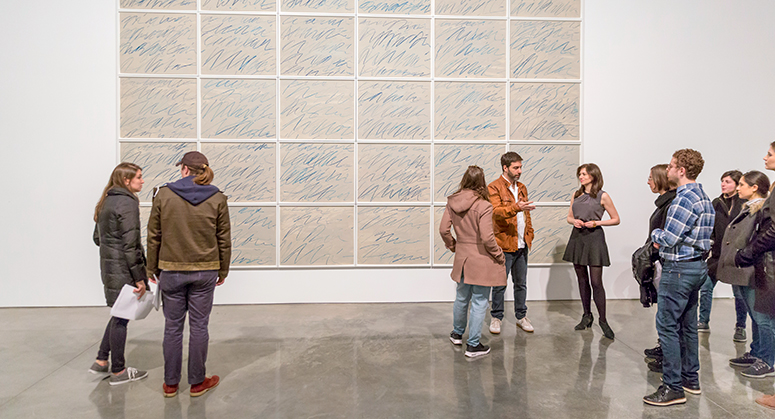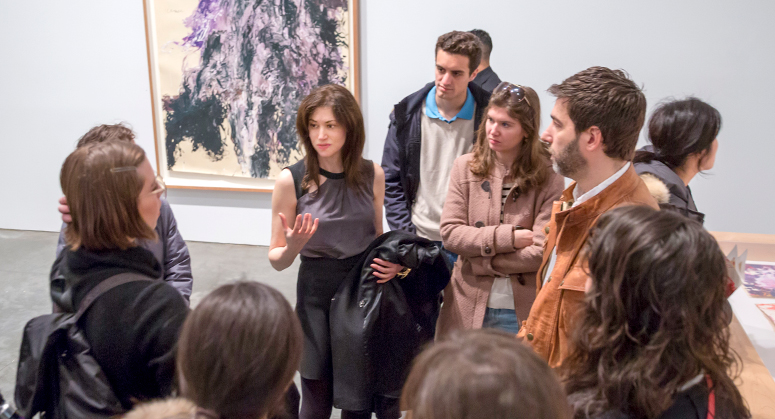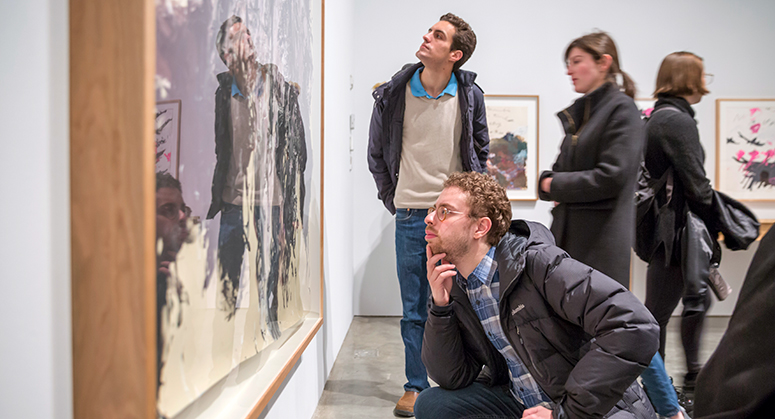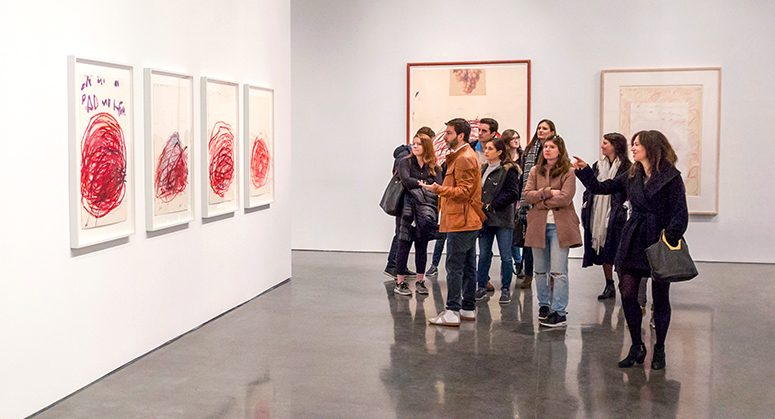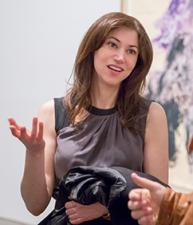One glance at the diversity of topics and readings in the syllabus for Art Law, an NYU Law course that Emily Kempin Professor of Law Amy Adler has taught for the past two decades, reveals that the class provides a compelling window into some of the most cutting-edge areas of law.
(All artwork in the photographs above and below copyright © Cy Twombly Foundation.)
The world of art implicates not only the First Amendment, property law, and copyright and trademarks, but also moral rights, the right of publicity, and questions of authenticity. Is it the government or its citizens who ultimately decide what art—a statue of Robert E. Lee, for example—belongs in public spaces? Where is the precise line between art and pornography? Who has the right to use your Instagram photos? A portrait of the multifarious legal issues at play might resemble one of Hieronymus Bosch’s more complex paintings.
With the ubiquitous smartphone having turned everyone into a content creator, the law is scrambling to keep pace. “A lot of the issues in art law are really issues about what the shift to a digital and photographic and visual culture means for law,” says Adler. “One of the pleasures of the class for me is to help students see the world they live in reflected in a law school classroom.”
The course is divided into three parts: art and the First Amendment, intellectual property in art, and the art market. The first section of the class may be the thorniest. Adler teaches, for instance, about the moral and legal complexities of infamous photographs such as the images of prisoners being tortured at the Abu Ghraib prison, the “napalm girl” photo taken during the Vietnam War, and pictures of distant figures falling to their deaths from the World Trade Center on 9/11.
During a lecture in March, Adler turned to the ongoing controversy over removing Confederate monuments and invited students to advocate for their own legal positions. The issues were complicated: the First Amendment government speech doctrine, the right of citizens to influence what sorts of monuments reside in public areas, the question of how to handle artifacts steeped in the most disturbing aspects of a nation’s history.
“Professor Adler is incredibly receptive to everyone’s perspective, but at the same time is willing to be a bit of a provocateur at times, and I think some of her writing absolutely goes in that direction,” says Avery Medjuck ’18, a past Art Law student. He adds, “She on the one hand is totally willing to hold a borderline-unpopular opinion, but on the other hand will not in any way shut the students down when they push back, sometimes hard.”
In this instance, Adler brought up the notion of allowing a Confederate monument to remain standing while also permitting the public to emblazon it with sentiments attacking white supremacy: “Can we have both the historical memory and the place to constantly attack it there?” She would, she adds, call such an approach “creative destruction.”
Evelina Yarmit ’19, a current student in the class, says she admires Adler’s willingness to grapple with controversial dilemmas that present no ready answers. “Obviously nothing is going to be resolved perfectly,” Yarmit says, “because you can’t resolve some of the things that we talk about. But particularly when we were talking about destroying monuments or taking down artwork that’s offensive, what I appreciate is she’ll say, ‘This is not something that we can solve easily, but this is a solution I personally think is interesting or I think is possible.’”
The class, which had 30 students when Adler first taught it 20 years ago, now has 112 and is one of the most popular courses at NYU Law. (Adler also co-teaches the much smaller Advanced Topics in Art Law Seminar and serves as faculty adviser of the Art Law Society, an active student organization.) “There is a very strong interest in the art world,” she explains, “not only because it’s an exciting realm of culture, but increasingly because it’s a high-profile realm in terms of the art market. The multibillion-dollar international market has been booming over the last decade or so and breaking all kinds of records, and it’s centered here in New York City. So it’s a very exciting story, not only about a realm of cultural expression but also about a transactional market that’s opaque and fascinating and hard to understand and super-prominent in our culture right now.”
Kibum Kim ’11, a onetime financial analyst who chose NYU Law for its strength in human rights law, says he enrolled in Art Law on a whim, then went on to take three more courses with Adler. Upon graduating, Kim began teaching at the New York campus of Sotheby’s Institute of Art after Adler facilitated an introduction. Two years ago, Kim relocated to the institute’s Los Angeles campus, where he is now associate director and head of the master’s degree program in art business. He also co-founded an art gallery, Skibum MacArthur, which recently merged with another LA gallery, Commonwealth and Council, where Kim will be a partner.
Kim praises Adler’s “nimble analytical mind that also has such a feel for the humanities and the poetics of art. She truly probed us and pushed us. She would present more challenging, experimental works of art and make us confront the motivations behind them and the points that the artists might have been trying to make—why even if something is not beautiful per se, it might be worthy of being in the canon and being discussed and influential—and then tie it to real legal issues.”
There is probably no better place for demonstrating the immediacy and importance of the art world than New York, and Adler routinely takes her classes on field trips to galleries and museums. On a balmy April afternoon this semester, Adler, along with Michael Straus ’80, chair of the Robert Rauschenberg Foundation’s board, guided students through half a dozen galleries, beginning with the David Zwirner Gallery, which was exhibiting works by Dan Flavin. Flavin’s art—fluorescent white light installations made from commercially available fixtures—presented the students with numerous legal riddles. Beyond the most obvious question of what constitutes art, Flavin’s limited-edition installation series are still sold after his death, with certificates of authenticity that are now signed by his son rather than the artist. (Not to mention that forgeries of said certificates have surfaced.) When a bulb burns out, the artist’s estate will sell the piece’s owner a new bulb. Ostensibly, this should not affect the work’s authenticity or value—but does it?
A week later, Adler accompanied students to a branch of Gagosian Gallery to see an exhibit of Cy Twombly drawings. David Baum ’97, secretary and outside general counsel of the Cy Twombly Foundation—who took Adler’s Art Law course the first time she taught it—led the way through the stark-white space.
Baum spoke not only about the art itself, but also his experience in art law, describing litigation the foundation had filed against two of its directors. Baum talked about what elements to include in contracts and the most strategic ways to enforce those provisions, and he explained the nuances of how artists’ estates and foundations make decisions about selling and exhibiting pieces in ways that can enhance an artist’s reputation and thus the value of the works, in a mutually reinforcing cycle.
While the majority of Adler’s students are unlikely to end up as immersed in the art world as Baum and Kim, the class also serves a more holistic purpose, Adler says. “I still get emails from former students who say, ‘You know, I went to see this show, and it made me think of the class.’ In their lives as lawyers, they’re still looking at art and connecting it to what we did in the classroom in a way that I find incredibly gratifying.”
Posted May 2, 2018
